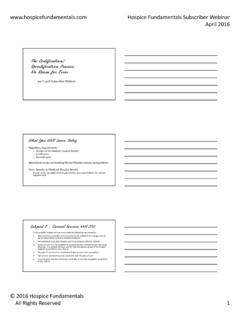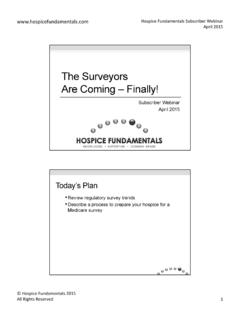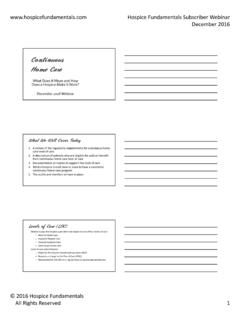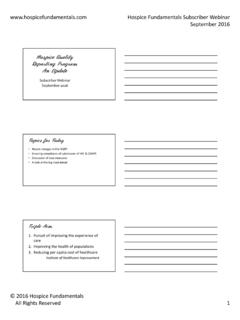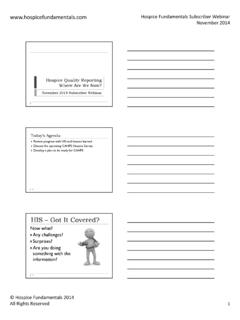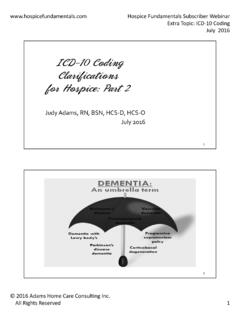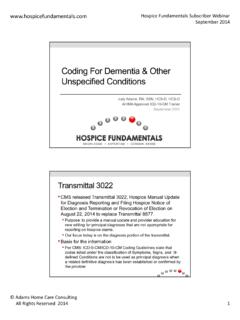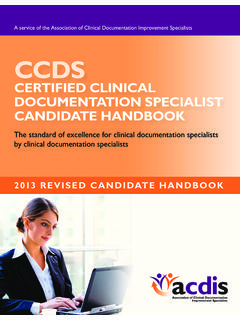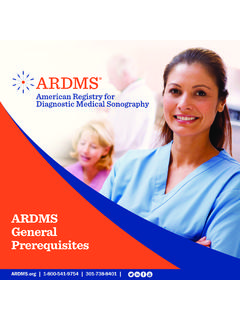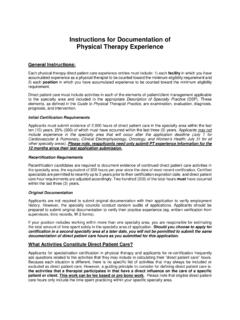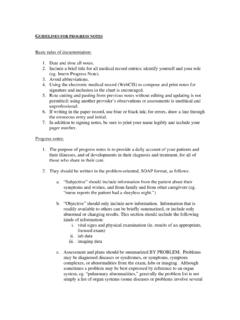Transcription of GIP: Getting It Right - Hospice Fundamentals
1 Fundamentals Subscriber WebinarAugust 2016 2016 Hospice FundamentalsAll rights Reserved1 GIP: Getting It RightAugust 2016 Subscriber WebinarThe Plan for This the regulatory requirements for general inpatient level of patients who are eligible for and can benefit from higher level of principles to support the general inpatient level of care and the connection with care planningLevels of Care (LOC)Medicare pays the Hospice a per diem rate based on one of four levels of care Routine Home Care Inpatient Respite Care general Inpatient Care Continuous Home CareLevel of care determination Made by the Hospice interdisciplinary team (IDG) Reevaluated by the IDG on a regular basis to assure appropriateness Requires a change to the plan of care (POC) Fundamentals Subscriber WebinarAugust 2016 2016 Hospice FundamentalsAll rights Reserved2 Hospices Not Providing All Levels of CareCategory No GIP NoCHC No Respite No GIP or CHCAll Hospices28% 58% 25%19%Bytotal # of Medicare Pts in 2013 Less than 100 57 715441100 199 25 602217200 299 17 581110300 499 85065500 or more 23921 MedPACR eport to the Congress.
2 Medicare Payment Policy March 2015 OIG Interest in GIP March 2016 Report Appropriate, 69%Inappropriate, 31%Inappropriate GIP stays, 201220% did not need GIP at all10% did not need GIP for part of stay1% no evidence of EOB or terminal illness OIG March 2016 Report On GIP Hospices did not meet care planning requirements for 85 percent of GIP stays 72 percent of GIP stays, the Hospice care plan was missing at least one key element In about half the stays, the Hospice care plan was not developed by all the required Fundamentals Subscriber WebinarAugust 2016 2016 Hospice FundamentalsAll rights Reserved3 OIG Recommendations to CMS1. Increase its oversight of Hospice GIP claims and review Part D payments for drugs for Hospice beneficiaries; 2. Ensure that a physician is involved in the decision to use GIP;3. Conduct prepayment reviews for lengthy GIP stays; 4. Increase surveyor efforts to ensure that hospices meet care planning requirements; 5. Establish additional enforcement remedies for poor Hospice performance; and 6.
3 Follow up on inappropriate GIP stays, inappropriate Part D payments, and hospices that provided poor quality care. CMS concurred with all six GIP Issues Identified by CMS documentation does not support the higher level of care Long stays Inappropriate use No plan initiated for discharge from GIP level of care Use of GIP for caregiver breakdown when medical symptoms do not support GIP Quality of care issues Compliance Challenges of Higher Level of Care Ensuring care is provided in accordance with the plan of care and meets professional management responsibilities Documenting the rational for moving to / from higher level of care Documenting to support higher level of care Increased scrutiny Fundamentals Subscriber WebinarAugust 2016 2016 Hospice FundamentalsAll rights Reserved4A View of the RegulationsGeneral Inpatient Care (GIP) A day in which a patient receives Hospice inpatient care for procedures necessary for pain control or acute or chronic symptom management that cannot feasibly be provided in other settings Where Contracted hospital (Medicare certified) Contracted skilled nursing facility (Medicare certified) Hospice inpatient facility a Hospice s own or contract (Medicare certified) Facility must have RN 24 hours/day who provides direct careMedicare Hospice Conditions of ParticipationGeneral Inpatient Clarification Final Rule CMS 1539 effective August 2007 Clarified GIP should only be used based on the patient condition When an individual s pain and symptoms must be closely monitored or the intensity of interventions that are required cannot be provided in any other settings GIP can not be used due to caregiver breakdown Advised respite should be used in these circumstances (respite cannot be used for residents of a nursing facility)
4 Fundamentals Subscriber WebinarAugust 2016 2016 Hospice FundamentalsAll rights Reserved5 general Inpatient Care The decision to change a patient s care to the general inpatient (GIP) level is based on the clinical condition of the individual general inpatient care requires the documentation of an acute change in the patient s condition, requiring aggressive, intensive treatment for the management of symptoms Why was the Hospice unable to manage the symptoms at the current level of care? general Inpatient Care Intensity of care directed towards pain control and symptom management that cannot be managed in any other setting Close monitoring of pain and symptoms Level of care needed to manage pain and symptoms is the basis for the GIP level of care procedures necessary for pain control or acute or chronic symptom management (e) general Inpatient CareGeneral inpatient care under the Hospice benefit is notequivalent to a hospital level of care under the Medicare hospital benefit A brief period of general inpatient care may be needed in some cases when a patient elects the Hospice benefit at the end of a covered hospital stay Patient continues to need pain control or symptom management Cannot feasibly provide in other settings while the patient prepares to receive home Fundamentals Subscriber WebinarAugust 2016 2016 Hospice FundamentalsAll rights Reserved6 GIP Level of Care in a Contracted Facility Hospice maintains professional management of the patient documentation by Hospice staff should reflect that management Should illustrate the coordination of care between the Hospice and the contracted facility providing GIP level of care On discharge need either a discharge summary or copy of the facility clinical record Includes residents of NF Discharge Criteria from GIP
5 Medical reasons for admission have stabilized Re established family support systemDischarge planning starts on admission and is reviewed daily What is Plan A? What is Plan B?Need for GIP Palliation / management of acute medical symptoms Observation and monitoring to control pain and other acute symptoms Require predominantly nursing care Actively dying? Must be a clinical need for services, such as pain control Caregiver breakdown? Must have a skilled nursing need going unmet because the caregiver is unwilling or unable to provide the skilled nursing Fundamentals Subscriber WebinarAugust 2016 2016 Hospice FundamentalsAll rights Reserved7 Psychological and Social ProblemsQuestions to ask & responses to document What is the specific patient care need going unmet as a result of the caregiver crisis? Why can t it be managed in the home? Does the patient need placement in a facility? Does the documentation tell the story? Cues for Need of GIP Increase calls to the office for help Difficulty managing symptoms with intermittent visits Increase in after hours calls Statements of wanting to go to the hospital or to call 911 Caregiver s anxieties and fears escalating to where no longer can provide skilled careHow Does GIP Work?
6 Setting Standards Fundamentals Subscriber WebinarAugust 2016 2016 Hospice FundamentalsAll rights Reserved8 Making it Happen Determine need for higher level of care meets the requirements (changes in comprehensive assessment) What happened that the patient needs and qualifies for a higher level of care Why can t the patient be managed at RHC? What are the assessment findings?Making it Happen RN contacts the physician regarding the change in the patient's condition and completes the following: Documents the discussion with the physician and any order changes Revises POC reflecting the level of care, new or exacerbation of problems necessitating the need for higher level of care, and any changes in interventions Involves all members of IDG in the changes to the plan of care Updates Hospice Aide assignment as applicable Assures the Medication/Patient Profile is updated and complete. Making it Happen Change level of care Arrange for transfer documentation should reflect what happened that the patient now needs and qualifies for GIP Interventions attempted and response by patient Fundamentals Subscriber WebinarAugust 2016 2016 Hospice FundamentalsAll rights Reserved9 Involvement of the IDG GIP is primarily focused on skilled nursing needs to met the unmet needs of the patient However.
7 The services of SWs and chaplains should also increase during these periods of crisis SW and chaplain continue to address the psychosocial / spiritual issues which may have escalated depending on the crisis When the Symptoms Are Managed Comprehensive assessment drives changes in POC, crisis is resolved and symptoms now managed Change in plan of care with IDG involvement How will the POC be different? What goals were met? Obtain physician orders as appropriate for any new medications / interventions, change in level of care So, How Does documentation Fit In With All of This? Fundamentals Subscriber WebinarAugust 2016 2016 Hospice FundamentalsAll rights Reserved10 Steps to Successful Documentation1. Identify the precipitating event(s) that led to need for higher level of care including any less than successful attempts to control symptoms that occurred prior to starting GIP2. Identify specific symptoms that are being actively addressed3. Document skilled care that patient requires and which cannot be managed without GIP4.
8 Describe the services provided documentation Prior to the CrisisThere must be a clinical need precipitated by a crisis for this level of care to be warranted What did the assessment show prior to initiation clinical need such as services for pain control, must be clearly evident in the documentation Response to interventions tried Admitting documentation What is the clinical need precipitated by the crisis Document failed interventions in the other setting (home, NF, ALF, etc.) Reasons why new interventions can t be provided in the other setting Why the family can no longer provide the care For patients in contract GIP in NF, how will the NF care be different? More intense? Involvement of IDG and attending physician in the decision to change to GIPP aint the picture why management in their current environment is not realistic Fundamentals Subscriber WebinarAugust 2016 2016 Hospice FundamentalsAll rights Reserved11 documentation of GIP Answer these questions Why here?
9 What is happeningthat can t be managed in the home or at current level in facility setting? Reflect a more intensive level of care should not read the same as routine home care notes Expect to see Changes to the plan of care and interventions Medication adjustments or other stabilization treatments Measures being taken to resolve the reason for admission or continued stay Supporting documentation that the family / NFcannot provide needed care Plan of Care Revise the plan of care Problems, interventions and expected outcomes Ensure assessments drive the plan of care Document response to plan of care and progress / lack of progress towards goals If no progress towards goals, adjust Plan of careAdmitting documentation Does this paint the picture why admitted? Patient continues to have increased dyspnea, respiratory distress, and associated anxiety, despite increase in steroids and other medication changes over the past 2 days. Patient in need of inhalation treatments every 2 3 hours and IV medications every 4 6 hours Would it support GIP admission?
10 Fundamentals Subscriber WebinarAugust 2016 2016 Hospice FundamentalsAll rights Reserved12 Daily DocumentationShould include What is the reason for level of care now (today) Assessment of signs and symptoms being managed Medication changes, titration, patient response Quantitative data ADL needs and dependency Vital signs Intake and output % of meals taken and quantity Pain ratings Caregiver teaching Discharge planning Paint the picture of the patient and patient needs as identified on the Plan of Care Visit Notes Continuously and consistently support the terminal prognosis and reason for GIP Reason for admission or continued stay to GIP level of care Measures being taken to resolve the reason for admission or continued stay Contain objective measures Contain vital signs, weights, body mass measurements, lab data/values, meal percentages, other objective data Documents to problems, interventions and goals in POC Wounds why is this complex care?
